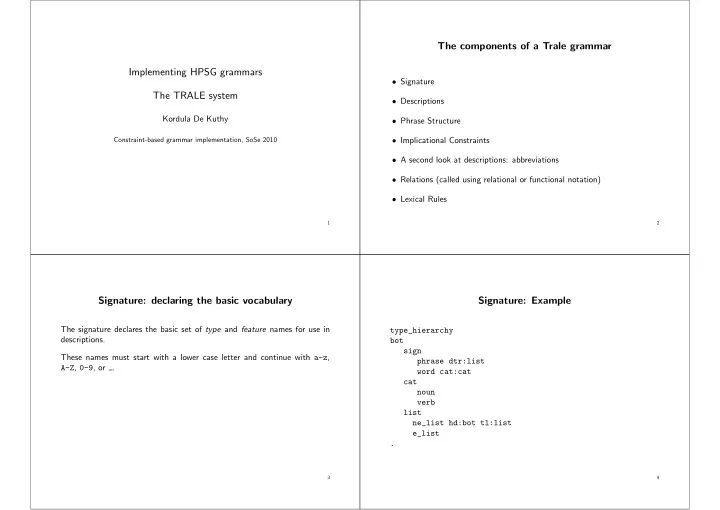

The components of a Trale grammar Implementing HPSG grammars • Signature The TRALE system • Descriptions Kordula De Kuthy • Phrase Structure Constraint-based grammar implementation, SoSe 2010 • Implicational Constraints • A second look at descriptions: abbreviations • Relations (called using relational or functional notation) • Lexical Rules 1 2 Signature: declaring the basic vocabulary Signature: Example The signature declares the basic set of type and feature names for use in type_hierarchy descriptions. bot sign These names must start with a lower case letter and continue with a-z , phrase dtr:list A-Z , 0-9 , or . word cat:cat cat noun verb list ne_list hd:bot tl:list e_list . 3 4
Signature: Example with multiple inheritance Descriptions type_hierarchy bot A description consists of sign phrase dtrs:list • a type specification: word starting with lower letters word cat:cat cat • a structure sharing: word starting with a capital letter nounish noun gerund • a compound description: path : description verbish with path consisting of feature or feature : path verb &gerund list ne_list hd:bot tl:list e_list . 5 6 Phrase Structure (I) Implicational Constraints HFP as specified in Pollard & Sag (1994) % I. Lexicon john ---> (word,phon:[(a_ john)],cat:noun). » phrase – » synsem | loc | cat | head – left ---> (word,phon:[(a_ left)],cat:verb). 1 → dtrs | head-dtr | synsem | loc | cat | head 1 dtrs headed-structure % II. Phrase Structure Rule: subj_head_rule rule can be specified in Trale as: (phrase,phon:[SubjPhon,HeadPhon],dtrs:[Subj,Head]) ===> cat> (Subj,word,phon:[SubjPhon],cat:noun), (phrase, dtrs:headed_structure) *> cat> (Head,word,phon:[HeadPhon],cat:verb). (synsem:loc:cat:head:H, dtrs:head_dtr:synsem:loc:cat:head:H). 7 8
A second look at descriptions Another look at descriptions Example from HPSG: Abbreviation used in Pollard & Sag (1994) Realization in Trale using logical variable macros Definition: Abbreviation Abbreviated AVM 2 3 synsem np(Index-index):= (local:(category:(head:noun, 2 3 » head – noun 6 7 NP 1 6 4 category 7 subcat:[]) subcat �� 6 6 7 7 local 4 5 5 content:index:Index)). content | index 1 vp(Cont-cont):= (local:(category:(head:verb, 2 3 synsem subcat:[synsem]) 2 3 " head # verb 6 7 VP: 1 6 7 content:Cont)). category D E 6 6 7 7 synsem local subcat 6 6 7 7 4 5 4 5 content 1 Use: john ---> (word,phon:[(a_ john)], synsem: @np((per:third,num:sing))). left ---> (word,phon:[(a_ left)], synsem: (@vp((leave-rel,leaver:Index)), local:category:subcat:hd:@np(Index))). 9 10 Expressing relational dependencies Functional notation for relations on lexical entries, phrase structure rules or implicational constraints Example from HPSG: The Subcat Principle Definition: 2 3 synsem | loc | cat | subcat 1 append([],ne_list,L) if true. “ ” 2 3 6 7 h i 4 head-dtr | synsem | loc | cat | subcat append 1 , 2 dtrs headed-structure 6 7 → append([H|T1],L,[H|T2]) if append(T1,L,T2). 6 7 dtrs “ ” 5 4 5 comp-dtrs synsem2sign 2 synsem2sign(e_list,e_list) if true. with the relations append/3 and synsem2sign/2 defined as follows synsem2sign([H|T],[synsem:H|NewT]) if synsem2sign(T,NewT). “ ” := append �� , 1 1 . Use: “ D E ” D “ ” E := 1 | 2 1 | append append , 3 2 , 3 . phrase *> (synsem:category:subcat:PhrSubcat, dtrs: (head_dtr:synsem:category:subcat:HeadSubcat, “ ” := comp_dtrs:CompDtrs) synsem2sign �� �� . goal “ D E ” D h i “ ” E := 1 | 2 | synsem2sign synsem2sign synsem 1 2 . synsem2sign(CompSynsems,CompDtrs), append(CompSynsems,PhrSubcat,HeadSubcat). 11 12
Functional notation for relations Lexical rules A Trale encoding of the Subcat Principle psp_lex_rule ## (dtrs:headed-structure) *> (synsem:loc:(cat:head:(vform:base, (synsem:loc:cat:subcat:MotherSubcat, aux:Aux), dtrs: (head_dtr:synsem:loc:cat:subcat: cont:Cont)) append(MotherSubcat,CompSynsems) **> comp_dtrs: synsem2sign(CompSynsems))) (synsem:loc:(cat:head:(vform:psp, aux:Aux), fun append(+,+,-). cont:(perfect_rel, append([],ne_list,L) if true. soa_arg:Cont))) append([H|T1],L,[H|T2]) if morphs append(T1,L,T2). be becomes been, give becomes given, fun synsem2sign(+,-). (X,[e]) becomes (X,ed), synsem2sign(e_list,e_list) if true. X becomes (X,ed). synsem2sign([H|T],[synsem:H|synsem2sign(T)]) if true. 13 14 References Pollard, C. & I. A. Sag (1994). Head-Driven Phrase Structure Grammar . Chicago, IL: University of Chicago Press. 15
Recommend
More recommend